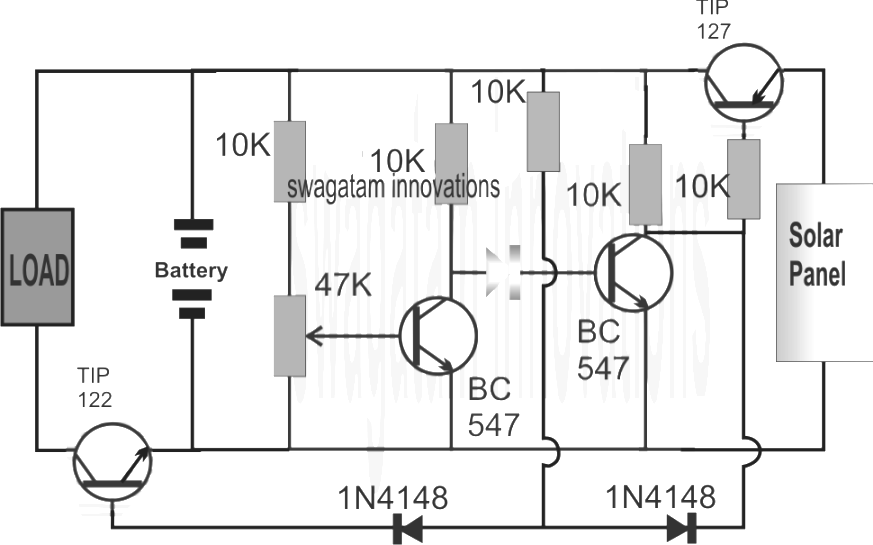The article describes a straightforward Li-ion solar charger circuit with automatic cut-off applying transistors mainly.
Solar Charger Circuit using Transistors with Automatic Cut-off

Loking at the above simple solar charger circuit using transistors, the automated cut off for the over charge level and the under level is performed by using a few BJTs put together as comparators.
Remember the earlier low battery indicator circuit employing transistors, in which the lower battery level was portrayed implementing merely a couple of transistors and some additional passive elements.
In this article we hire equivalent design for the detection of the battery levels as well as for reinforcing the specified switching of the battery over the solar panel and the attached load.
Let's believe in the beginning we own a moderately discharged battery that causes the 1st BC547 from left to end conduction (it is fixed through adapting the base preset to this particular limit), and makes it possible for the subsequent BC547 to perform.
The moment this BC547 acts it help the TIP127 to switch ON, which makes it possible for the solar panel voltage to arrive at the battery and start charging it.
The above mentioned circumstance alternatively helps to keep the TIP122 powered down in order that the load cannot function.
As the battery starts out acquiring charge, the voltage throughout the supply track likewise start off increasing right up until a degree in which the left side BC547 is simply in a position to run, evoking the right side BC547 to quit performing any more.
The instant this takes place, the TIP127 is blocked from the negative base signals and yes it steadily ceases conducting in a way that the battery little by little becomes cut-off from the solar panel voltage.
Nonetheless, the above mentioned condition makes it possible for the TIP122 to bit by bit obtain a base biasing trigger and it starts out conducting....that helps to ensure that the load now is capable of getting the specified supply for its procedures.
The above discussed Li-ion Battery solar charger circuit using transistors along with auto cut-offs works extremely well for almost any small range solar controller programs for instance for charging cellphone battery packs or other styles of Li-ion battery packs correctly.
For getting a Controlled Charging Supply
The style may be simply revised for empowering a regulated fixed voltage supply for the battery, as proven beneath:

Hi,
What is the minimum input voltage for this circuit?
Nelio
It is 3v…
Hi,
Do I need to do any changes in order to charger a 3.7V Li-Ion Battery?
Nélio.
Hi, you can replace all the 10k with 2.2k
Hi,
What is the purpose of the LED?
In which conditions does it light up?
Hi, It shows the battery is charging…
what is the diode no. that is in red on schematic
There is no red colored part in the above schematic….but there is an LED at the center